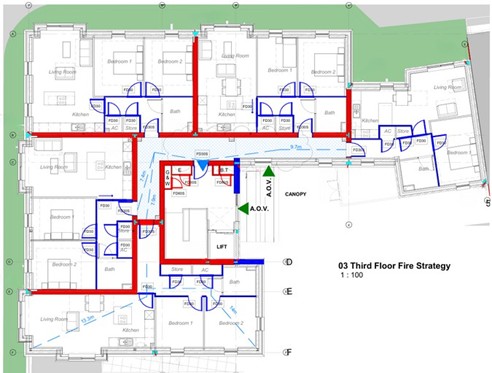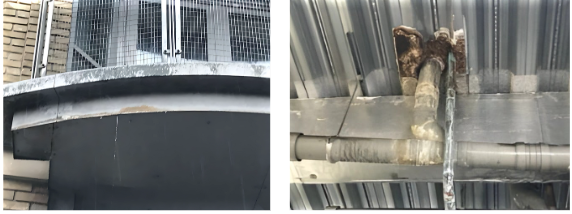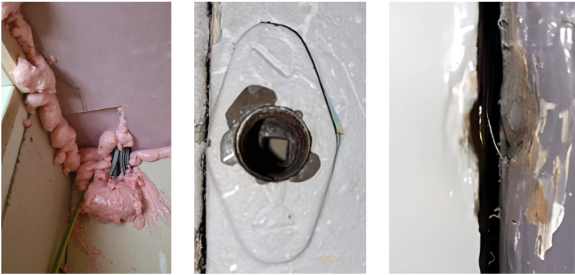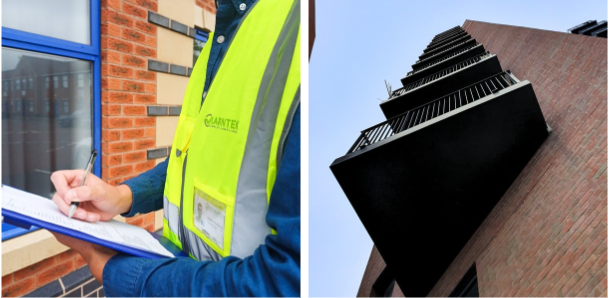A Building Safety Case Report is now required by the Building Safety Act 2022 for High-Rise Residential Buildings. The BSA 2022 was developed after the Grenfell catastrophe, causing property managers across the country to ask themselves the same difficult question. If there was a fire, would the people I’m responsible for be in danger?
Karntek can provide the answers you need to settle those doubts. We now provide Building Safety Cases, enabling you to manage the ongoing continuity of the Golden Thread of Compliance for your building. We conduct a Gap Analysis, assessing details on your building’s current safety measures, procedures and risk assessments. From the Gap Analysis we can identify any gaps in your key building information, and recommend the necessary assessments and inspections needed to create a full profile for your Building Safety Case. This enables you to identify issues and risks and work to reduce the devastating impacts fire can have.
The information needed to complete the Building Safety Case includes the building’s fire strategy, structural information, safety management system, fire compartmentation survey, fire risk assessment, fire risk appraisal of external walls and resident engagement strategy. A Building Safety Case is far from simple, with a multitude of different aspects. Luckily for you, Karntek can help with every single element, getting you ready to receive your Building Assessment Certificate from the BSR.
Fire Strategy
With every fire strategy, the ultimate goal is to minimise the risk to life. In order to do this, a structured response to fire emergencies must be created, as well as detailed plans to prevent fires happening and to prevent their spread.
Included in a fire strategy is:
- Measures to reduce the risk and spread of fire, including fire-resistant materials, storing flammable substances safely, and regular qualified inspections.
- Detection systems and alerting process; the installation of fire alarms, sprinkler systems and smoke detectors.
- Evacuation plan, and the training and drills involved in ensuring occupants know how to respond to a fire.
- Plans for access for the fire service, including firefighting lifts, wayfinding signage and risers.
Structural Surveys
Structural Surveys provide evidence that the building doesn’t have any weaknesses that could lead to total or partial weaknesses. These inspections evaluate the condition of a building’s structure. The survey identifies any weaknesses and defects in the building’s framework. This includes the walls, floors, foundations, roof and other load-bearing structures. A structural survey gives property owners a clear overview of the condition and safety of their structure, and the necessary steps needed to repair or maintain the building.
The inspections should include the following:
- Type of structural survey conducted
- Methods used; visual or invasive
- The inspector employed
- Why the survey was carried out, and the reason for the chosen method.
- The findings, presented to all relevant stakeholders.
Safety Management Systems
A Safety Management System gives a clear record of the building’s regular safety checks, maintenance records, contractor work, and all documents associated with the building. Included in the SMS is documentation of all safety objectives and processes, so property managers can be held accountable for ensuring compliant procedures and policies are put in place. Roles and responsibilities must be outlined, and a consistent commitment to continuous improvement should be present in all decisions made.
The government has provided guidance for safety management systems for high-rise residential buildings. They recommend the following framework:
- Plan: determine your policy and plan for implementation
- Do: assess risks and implement your plan
- Check: measure performance
- Act: review performance and act on lessons learned
Compartmentation Surveys
Fire is unpredictable. It’s lethal, and the destruction it leaves behind is no joke. In the event of a fire, smoke is more of a threat than the actual flames, due to the poisonous gasses spreading incredibly fast. Compliant compartmentation is the only way to make sure flames and smoke are contained. Picture your building as a box, filled with smaller boxes. If a fire starts in one of these boxes, every measure should be in place that the danger doesn’t spread beyond that compartment. Compartmentation surveys should be conducted so building managers can plan effective evacuation strategies, and, if necessary, ensure remedial works happen.
Compartmentation is dividing a building or structure into individual segments. This is done by using fire-resistant materials for walls, floors and ceilings, and using fire-rated doors. Furthermore, internal windows should have fire-rated glazing. When buildings are constructed, they should ideally avoid large, open spaces with limited internal walls, as this encourages rapid spread of fire.
Fire Risk Assessments
It is easy to think of a Fire Risk Assessment as a tick-box exercise, but there is much more to it. Assessing the risk is just the beginning, then various actions and measures will need to be implemented in order to remedy
There are 5 key steps to a basic Fire Risk Assessment:
- Assess Fire Hazards
- Assess People at Risk
- Evaluate and Act
- Record, Plan and Train
- Review
Fire Risk Appraisal of External Walls
Do you know the design and materials of the external walls in your building? Building owners are required to provide this information for Fire and Rescue Services. A suitably qualified specialist must be employed to undertake the assessment. An FRAEW is applicable where the risk is suspected or known, due to the form of the construction materials used, such as combustible materials.
This appraisal has two main elements. Firstly, it assesses the combustibility of materials used on external walls of a building. Secondly, it evaluates the installation process of the external walls. The FRAEW is in accordance with PAS9980, providing building owners and managers with peace of mind as to the safety of their residents. An EWS1 must be considered with an FRAEW. This is a lender certificate, which views the potential for the loss of property, whereas an FRAEW views the external walls from a risk-to-life perspective.
Resident Engagement Strategy
The aim of the strategy is to ensure residents are involved in their building’s safety and have access to information regarding building safety. In order to make sure every resident is safe and understands what they can do to improve their building’s safety, engagement should occur via multiple different channels. To make sure communication is effective, engagement must be measured so any uninvolved residents can be identified.
What are the key features of this strategy?
- Understanding building and resident profile
- Ensure clarity and accessibility of information
- Consultation with residents
- Communication methods
- Measuring engagement
- Realistic approach
We know, it’s a lot of information. That’s why we have created a certified CPD session designated to helping property managers understand Building Safety and the legislation surrounding it. To book a session with our experienced, qualified team, drop us an email at sales@karntek.com. Our aim is to simplify the complex environment of government legislation, translating it into information and recommendations that are defined with clarity.
Frequently asked questions
A Building Safety Case is all the information that has been gathered about the property and it’s safety. This then gets submitted to the Building Safety Regulator. When it has been reviewed and they are happy the building’s safety meets all the requirements, they will issue a Building Safety Certificate.
The Building Safety Regulator charges £144 an hour for assessing the Safety Case. The FOI have estimated that each case takes an average of 123 hours to review. This is a total cost of £17,712. We have structured our process for Building Safety Cases and Reports to reduce the time taken to review the case, saving thousands of pounds for leaseholders.
Access more information here
Unsure? Confused? Worried? Click here to ask a question








